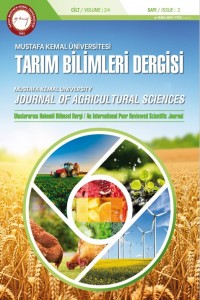Abstract
Aims: In this review, it is aimed to discuss the current state of nitrogen pollution caused by dairy cow breeding and to offer suggestions to improve nitrogen use efficiency of dairy cattle.
Methods and Results: For evaluation, the data in web pages of related institutions and the articles published in scientific journals were used. Nitrogen utilization in dairy cows is relatively inefficient.
Conclusions: One of the most important problems related to the loss of nitrogen in dairy cow rations is environmental. A significant portion of cattle manure nitrogen, primarily from urinary urea, can be converted to ammonia through enzymatic degradation and eventually lost to the atmosphere. The negative effects of ammonia in the environment are connected with the formation of acid rain, soil and surface water eutrophication, nitrate contamination of ground waters, as well as the formation of fine particulate matter. It may also contribute to the global warming through nitrous oxide formation. In general, the nitrogen loss increases when rumen produces more ammonia than can be used in the rumen. Another loss of nitrogen in ruminants is due to the use of amino acids after absorbtion for gluconeogenesis instead of for protein synthesis. Also, imbalanced supply of amino acids in relation to requirements for milk protein synthesis increases the loss of nitrogen.
Significance and Impact of the Study: The volatilization of ammonia from manure can be reduced through cow management, nutrition and manure treatment techniques. Reducing ammonia emissions from dairy cattle farms is important to achieving environmentally sustainable animal production that will benefit producers.
Keywords
References
- Agle M, Hristov AN, Zaman S, Schneider C, Ndegwa PM, Vaddella VK, 2010. Effects of ruminally degraded protein on rumen fermentation and ammonia losses from manure in dairy cows. Journal of Dairy Science93:1625-1637.
- Alexander RB, Smith RA, Schwarz GE, Boyer EW, Nolan JV, Brakebill JW, 2008. Differences in phosphorus and nitrogen delivery to the Gulf of Mexico from the Mississippi River Basin. Environmental Science and Technology, 42(3):822-830.
- Amann M, Bertok I, Borken-Kleefeld J, Cofala J, Heyes C, Höglund-Isaksson L, Sandler R, 2011. Cost-effective control of air quality and greenhouse gases in Europe: Modeling and policy applications. Environmental Modelling and Software, 26(12): 1489-1501.
- Amann M, Borken-Kleefeld J, Cofala J, Hettelingh JP, Heyes C, Höglund-Isaksson L, Posch M, 2014. The final policy scenarios of the EU Clean Air Policy Package. International Institute for Applied Systems Analysis (IIASA), Laxenburg, Austria.
- Anonim, 2014. Tarımda iş sağlığı ve güvenliği. Çalışma ve Sosyal Güvenlik Bakanlığı İş Sağlığı ve Güvenliği Genel Müdürlüğü.http://www.gelisimosgb.com.tr/Assets/images/Tarimda_Is_Sagligi_ve_Guvenligi_Rehberi_20170725_105051.pdf. (Erişim tarihi:10.02.2018)
- Anonim, 2015. Düşük karbonlu ekonomiye geçiş ve Paris COP 21 zirvesi. http://www.globalcompactturkiye.org/Mailing/COP21BilgiNotu. (Erişim tarihi:10.02.2018)
- Anonymous 2008. Directive 2008/50/EC of The European Parliament and of the Council of 21 May 2008 on ambient air quality and cleaner air for Europe.http://eur-lex.europa.eu/LexUriServ. (Erişim tarihi:15.08.2018)
- Anonymous, 2009. Emergency planning and community right-to-know act (EPCRA) requirements. http://www.epa.gov/emergencies/content/epcra/index.htm (Erişim tarihi:10.06.2018)
Abstract
Amaç: Bu derlemede, süt sığırcılığı kaynaklı azot kirliliğinin mevcut durumunu tartışmak ve süt sığırlarının azot kullanım etkinliğini artırmak için öneriler sunulması amaçlanmıştır.
Yöntem ve Bulgular: Çalışmada, bilimsel dergilerde yayınlanmış makalelerden ve konu ile ilgili kurumların web sayfalarındaki verilerden yararlanılmıştır. Süt sığırlarılarınnın rasyon azotunu kullanım etkinliği genel olarak düşüktür.
Genel Yorum: Süt sığırı rasyonlarında azot kaybıyla ilgili en önemli sorunlardan biri çevre ile ilgilidir. Altlıktan önemli miktarda azot, özellikle idrardan, enzimatik yıkım sonunda amonyağa dönüşerek atmosfere karışmaktadır. İnce partiküler madde ile asit yağmurları oluşumu, yeraltı sularında nitrat kirliliği ve toprak-yüzey sularında ötrofikasyonu artırması amonyağın çevre ile ilgili olumsuz etkileridir. Amonyak ayrıca, diazot monooksit yoluyla sera gazı oluşumuna katkı sağlamaktadır. Genel olarak, rumende mikroorganizmaların kullanabileceğinden fazla amonyak üretilmesi idrarla azot kaybını artırmaktadır. Ruminantlarda azot kaybının bir diğer nedeni, aminoasitlerin protein sentezi yerine glikoneojenez amacıyla kullanılmasıdır. Ayrıca, süt proteini sentezi gereksinimine göre ayarlanmamış dengesiz aminoasit içeren rasyonlar azot kaybını artırmaktadır.
Çalışmanın Önemi ve Etkisi: Altlıktan amonyak salınımı bazı yetiştiricilik, besleme ve altlık uygulamalarıyla önemli ölçüde düşürülebilmektedir. Süt sığırı işletmelerinden amonyak salınımını düşürmek, üreticilere faydasının yanında sürdürülebilir bir çevre için önemlidir.
Keywords
References
- Agle M, Hristov AN, Zaman S, Schneider C, Ndegwa PM, Vaddella VK, 2010. Effects of ruminally degraded protein on rumen fermentation and ammonia losses from manure in dairy cows. Journal of Dairy Science93:1625-1637.
- Alexander RB, Smith RA, Schwarz GE, Boyer EW, Nolan JV, Brakebill JW, 2008. Differences in phosphorus and nitrogen delivery to the Gulf of Mexico from the Mississippi River Basin. Environmental Science and Technology, 42(3):822-830.
- Amann M, Bertok I, Borken-Kleefeld J, Cofala J, Heyes C, Höglund-Isaksson L, Sandler R, 2011. Cost-effective control of air quality and greenhouse gases in Europe: Modeling and policy applications. Environmental Modelling and Software, 26(12): 1489-1501.
- Amann M, Borken-Kleefeld J, Cofala J, Hettelingh JP, Heyes C, Höglund-Isaksson L, Posch M, 2014. The final policy scenarios of the EU Clean Air Policy Package. International Institute for Applied Systems Analysis (IIASA), Laxenburg, Austria.
- Anonim, 2014. Tarımda iş sağlığı ve güvenliği. Çalışma ve Sosyal Güvenlik Bakanlığı İş Sağlığı ve Güvenliği Genel Müdürlüğü.http://www.gelisimosgb.com.tr/Assets/images/Tarimda_Is_Sagligi_ve_Guvenligi_Rehberi_20170725_105051.pdf. (Erişim tarihi:10.02.2018)
- Anonim, 2015. Düşük karbonlu ekonomiye geçiş ve Paris COP 21 zirvesi. http://www.globalcompactturkiye.org/Mailing/COP21BilgiNotu. (Erişim tarihi:10.02.2018)
- Anonymous 2008. Directive 2008/50/EC of The European Parliament and of the Council of 21 May 2008 on ambient air quality and cleaner air for Europe.http://eur-lex.europa.eu/LexUriServ. (Erişim tarihi:15.08.2018)
- Anonymous, 2009. Emergency planning and community right-to-know act (EPCRA) requirements. http://www.epa.gov/emergencies/content/epcra/index.htm (Erişim tarihi:10.06.2018)
Details
| Primary Language | Turkish |
|---|---|
| Subjects | Zootechny (Other) |
| Journal Section | Derleme |
| Authors | |
| Publication Date | August 27, 2019 |
| Submission Date | December 20, 2018 |
| Acceptance Date | July 16, 2019 |
| Published in Issue | Year 2019 Volume: 24 Issue: 2 |


